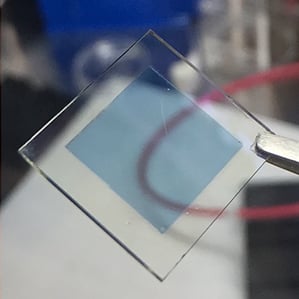Smart Windows Just Got Cooler
Window glass that can tint on demand is pretty slick, but a new advancement has made it even cooler—and that could help the technology finally go mainstream.

Smart glass has been around for decades, but it is quite pricey and has found only niche applications, such as the windows of a new Boeing jetliner. But a new kind of electrochromic window glass, which changes color in response to the addition or removal of electronic charge, is more versatile than the technology now on the market, and it could be cheaper, too.
Commercially available materials can block only the visible component of sunlight, allowing the invisible near-infrared component, which produces heat, to pass through. A new type of glass developed by a group led by Delia Milliron, a professor of chemical engineering at the University of Texas at Austin, can selectively block the heat-producing component as well as the visible light. Milliron says the performance is now good enough for a startup she cofounded to move forward with plans to build a prototype manufacturing line based on these recent advances.
Key to the smarter window glass is a “framework” of nanocrystals made of an electrically conductive material, embedded in a glassy material. The nanocrystals and the glassy material have distinct optical properties, which change when the materials are electronically charged or discharged. The nanocrystals can either block near-infrared light or allow it to pass through, while the glassy material can transition between a transparent state and one that blocks visible light.
The “nanocomposite” is able to block up to 90 percent of the near-infrared light and 80 percent of the visible light, and in addition to the standard bright and dark modes it features a “cool” one, which could help buildings save energy during hot days. It can switch between modes in just minutes—faster than any commercial electrochromic window material Milliron knows of. Combined with less expensive and potentially more reliable manufacturing techniques, these attributes could bolster the new material.
The manufacturing approach of the startup, called Heliotrope Technologies, is different from that of today’s electrochromic-glass makers, which have struggled with low yields, says Milliron. Whereas conventional manufacturing techniques rely on energy-intensive processes similar to those used to make certain kinds of microelectronics, the technology Heliotrope aims to commercialize is made by depositing solutions onto glass films, which is faster and requires less energy.
Milliron’s technology works much like a rechargeable battery. Imagine that the device starts out in the transparent, bright state. Applying a certain amount of voltage—say, by turning a switch—will charge the nanocrystals, which makes them absorb near-infrared light. If the device is charged for a bit longer, the glassy material also becomes charged, darkening as a result. Discharging the window glass brings back the fully transparent state.
In the latest demonstration, Milliron and her colleagues showed that arranging the nanocrystals in a specific architecture allows electrons and ions to move quickly between the glassy material and the nanocrystals, meaning the composite can switch between modes much faster than before. As an added benefit, whereas a previous iteration had a brownish tint, the new nanocrystal material creates a more neutral blue tint, which Milliron says is considered essential for many consumer applications. Heliotrope’s president, Jason Holt, says the company expects to bring its first products to the market in 2017.
Keep Reading
Most Popular
Large language models can do jaw-dropping things. But nobody knows exactly why.
And that's a problem. Figuring it out is one of the biggest scientific puzzles of our time and a crucial step towards controlling more powerful future models.
The problem with plug-in hybrids? Their drivers.
Plug-in hybrids are often sold as a transition to EVs, but new data from Europe shows we’re still underestimating the emissions they produce.
Google DeepMind’s new generative model makes Super Mario–like games from scratch
Genie learns how to control games by watching hours and hours of video. It could help train next-gen robots too.
How scientists traced a mysterious covid case back to six toilets
When wastewater surveillance turns into a hunt for a single infected individual, the ethics get tricky.
Stay connected
Get the latest updates from
MIT Technology Review
Discover special offers, top stories, upcoming events, and more.